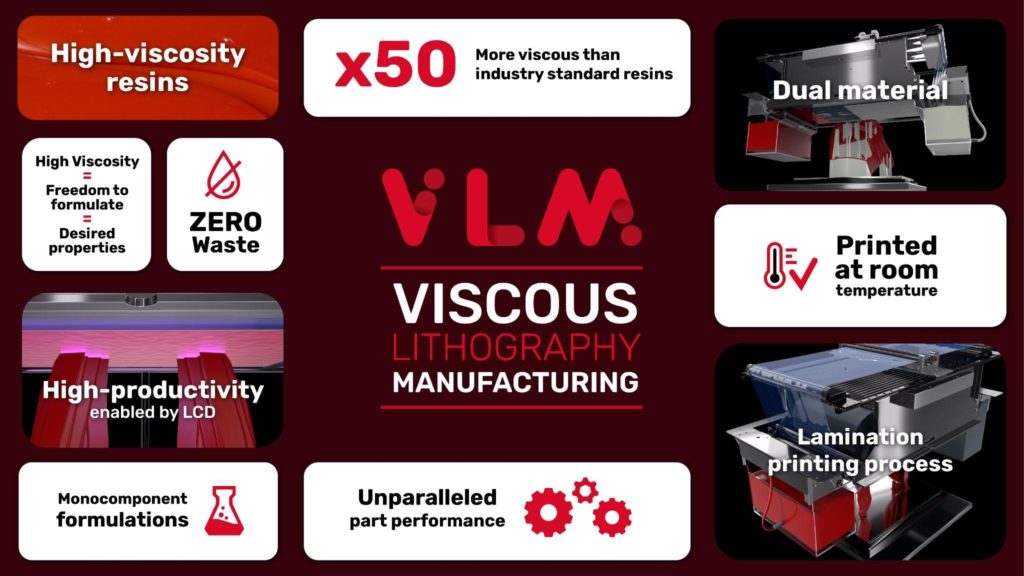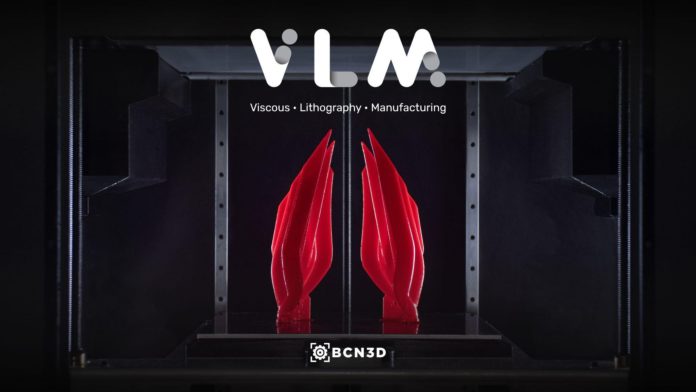It’s been a few weeks that machine manufacturer BCN3D has been conducting a teaser campaign for a new product it has been developing for the past three years – the product has been unveiled yesterday: a Viscous Lithography Manufacturing (VLM)TM technology.
The new solution ambitions to unlock manufacturing autonomy by processing high viscosity resins for better mechanical properties and by delivering productivity and accessibility.
How does it work?
VLM is a patented lithography-based 3D printing process that laminates thin layers of high viscosity resins onto a transparent transfer film, producing high-performance parts rapidly and affordably. What distinguishes VLM from other resin technologies on the market is its ability to process resins 50x more viscous than the industry standard, a press communication reports.
The machine has been designed to the extent that the system enables the resin to be laminated from both sides of the film. This can accelerate the printing speed and facilitates the processing of various resins to achieve multi-material parts.
The mechanical system allows the resin to be laminated from both sides of the film, making it possible to implement strategies to speed up printing times or combine different resins to get multi-material parts with easy-to-remove support structures.
Furthermore, the use of a light source (UV light and LCD Screen) delivers a constant time per layer, no matter what number of parts are produced. In addition, the fact that the machine is not limited by the vat dimension, a complex temperature, or tricky components, makes it easy to scale up with a bigger LCD screen.
According to the machine manufacturer, without a strict low viscosity constraint, chemical companies obtain the freedom to formulate, as a whole new set of ingredients and modifiers can be added in the resin to achieve the desired effect on thermal and mechanical properties. VLM processes resins that obtain 3x the amount of impact resistance for rigid materials and a 200% increment in tear strength compared to industry-standard formulations.
As far as materials are concerned, it should be noted that the ability of the machine to process high viscosity resins is the result of a joint development agreement between high-performance photocurable resins’ producer Arkema & BCN3D. Together, both companies ensure that materials developed for VLM deliver properties that can’t be reached with other resin-based 3D printing processes.
“If 3D printing is to be the future of manufacturing, and what leads us towards local production, customization, control of supply chains and sustainability, all the players in the industry should be pushing in this direction. At BCN3D, we think that today is the first step in achieving this goal with the new Viscous Lithography Manufacturing (VLM) technology. We want to show 3D printing in a new light so that it becomes the pivotal point of manufacturing” – Xavier M. Faneca, CEO of BCN3D.
 What do first users think of VLM?
What do first users think of VLM?
Motorsport and advanced technology company Prodrive has been one of the first companies to appreciate the capabilities of VLM. The company that collaborated with MakerBot during DAKAR 2021 has been assembling end-use parts made with VLM mounted directly on cross-country cars.
“VLM technology seemed to combine all the best features of the different Additive Manufacturing technologies, and even offer some unique advantages. For Prodrive, materials are the key to making durable end-use parts. VLM allows us to continue to use the engineering materials that we know and love, but instead in significantly finer resolution in all three directions, and the material is much more homogeneous, making the finished parts behave much more like a traditional injection molded part”, Callum Harper, Design Engineer at Prodrive comments.
In the same vein, automotive glass manufacturer Saint Gobain has been fabricated 7000 positioning fixtures in 7 days with VLM, for 0.79€ per part and a subsequent annual saving of 70.000€.
“VLM technology has empowered us to see significant improvement in the future. Our main goal is to reduce our dependence on external mechanization suppliers and do it internally instead with technologies such as VLM. Doing so is what would give us the power of manufacturing autonomy.” – Alberto Rodriguez Fernandez, World Class Manufacturing Manager at Saint Gobain.
Accessibility
Unlocking manufacturing autonomy using 3D printing shouldn’t be just for Fortune 500 companies, but for every single business that develops and manufactures concepts or products, in any industry. VLM-based solutions will be under 50.000 euros, with a compact footprint, no dedicated space or critical infrastructure. This low entry barrier, in combination with its big printing volume and high throughput, puts the fixed cost of the solution ahead of the rest. By implementing the use of VLM, the cost per part is significantly lower than those of powder-based and resin-based technologies, a press release reads.
Lastly, to enable the entire industry to take advantage of this solution, BCN3D has launched a VLM Technology Adoption Program. Its new Applications Center will be operated by dedicated AM specialists and host the upcoming VLM-based hardware solutions.
Partakers will join Saint Gobain and Prodrive in being the first to discover the new VLM and experiencing its full potential for themselves with real 3D printed parts, and individual attention on their exact printing needs.
Remember, you can post job opportunities in the AM Industry on 3D ADEPT Media free of charge or look for a job via our job board. Make sure to follow us on our social networks and subscribe to our weekly newsletter : Facebook, Twitter, LinkedIn & Instagram ! If you want to be featured in the next issue of our digital magazine or if you hear a story that needs to be heard, make sure you send it to contact@3dadept.com






